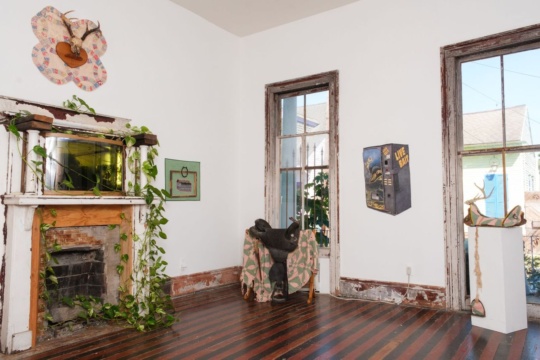
Can you write a sentence without using texting language? Can people still have face-to-face conversations? Can the word “bitch” be used in a positive way? Are hashtag campaigns really activism? These are questions I’m (indirectly) bombarded with as a millennial in America. People are talking about language. “Beyond the Vernacular,” which closes today at Mammal Gallery, surveys the spectrum of expression and considers words, their meaning, and their method of delivery. Each of the nine artists—Ify Akiti, Devin Brown, Grace Thornton, Jessica Caldas, John Carroll, Brian Egan, Heather Greenway, Jordan Stubbs, and Katie Troisi—manipulates language in his or her own way, so the very fact that he or she chose to display the particular works on view becomes a manifestation of the creator’s individual language.
Carroll’s blackout poetry represents the multifaceted nature of language. His artworks, created by covering book pages with acrylic so that certain words are left showing, form phrases such as: “Be the exception” and “We don’t need to be fixed.” But it’s not the phrases that make Carroll’s work particularly meaningful or indicative of the state of language in 2014. Instead, it’s the fact that only he would create those poems from those pages. It’s that his poems are representative of his thoughts, feelings, and situation. It’s that he’s destroying what came before and creating new language and meaning on top of it. It’s that blackout poetry is not rare but a meme, a language that we can all share via Carroll’s Instagram account. It’s that it is what’s here, in the present and now.

On the opposite end of the visual spectrum lies Greenway’s abstract paintings, in which no single word appears—an outlier in an exhibition about language, but a method of communicating all the same. In Greenway’s Our Fancy Things, brushstrokes combine to resemble imperfect letters, or just brushstrokes, depending on how you look at it. As apps for gif messaging and emoji proliferate, I’ve heard people jokingly speculate that one day we’ll be able to communicate with images alone. The inclusion of Greenway’s work is integral to the exhibition. Because it is so symbolic—I might even say hieroglyphic—it serves to show that each viewer brings his or her own context and meaning to the work, as with other forms of language. Egan, too, seems to appreciate the symbolic nature of words as he presents word groupings on crumpled pieces of graphing paper that, when associated, compel me to imagine related imagery. What matters more than how language is presented is how it’s interpreted.
A conversation about language in contemporary society could not be complete without a conversation about the role of technology. Thornton and Brown’s voyeuristic video Sext Me Sometime comments on the awkwardness of sexting, a process that is at once personal and impersonal, but more importantly, it comments on the nature of digital interaction. Its flashiness coincides with Troisi’s paintings, the varied shapes of her panels resembling text message boxes, messages like “Do you like your feet massaged and kissed? What size are your feet” almost indecipherable beneath layers of paint. Caldas’s Definitions of Behavior and Identity, unceremoniously displayed in boxes on a table, presents Urban Dictionary definitions next to Webster definitions of words related to social and gender issues. By doing so, Caldas addresses people’s ability to ascribe different meanings and connotations to a word and acknowledges the impact of the evolution of language.

At times, the multiple ideas, styles, and viewpoints in the exhibition become overwhelming, a testament to the difficulty of tackling a topic as monstrous as language in the Internet age. I left the exhibition understanding more about language’s complexity and less about language itself. “Beyond the Vernacular” tells us that contemporary language isn’t bastardized. Language is shifting, subjective, polarizing, evolving, and confusing—as it should be.
Yves Jeffcoat is an Atlanta-based writer.




